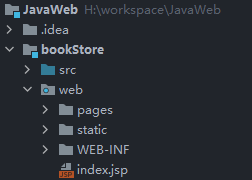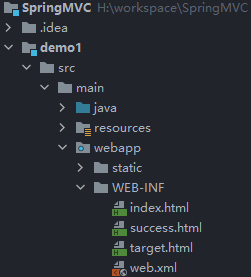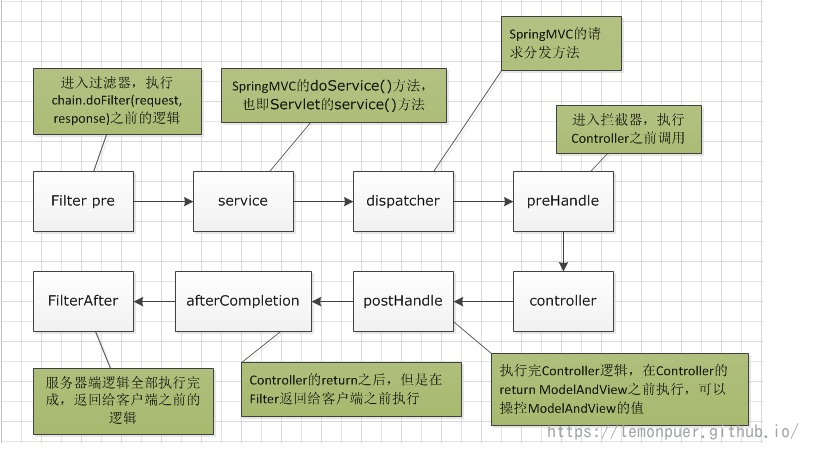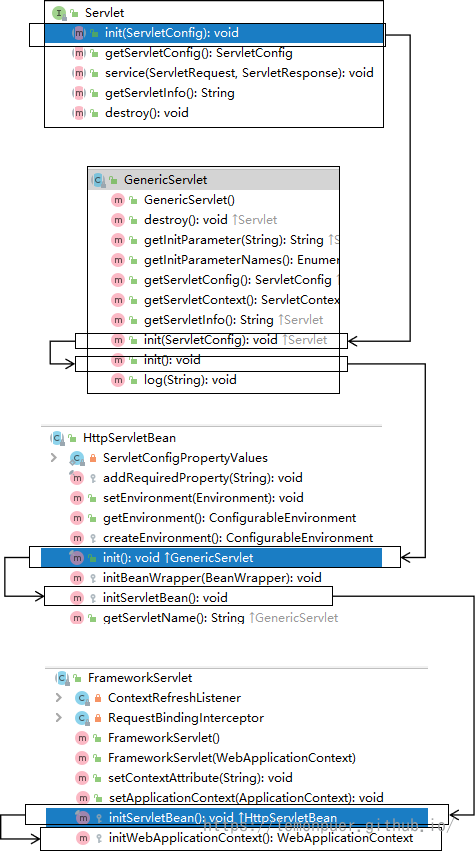1. SpringMVC简介 MVC是一种软件架构的思想,将软件按照模型、视图、控制器来划分(在JavaWeb.thymeleaf有详细介绍)
SpringMVC是Spring的一个后续产品,是Spring的一个子项目,是 Spring 为表述层开发提供的一整套完备的解决方案。
注:三层架构分为表述层(或表示层)、业务逻辑层、数据访问层,表述层表示前台页面和后台servlet
SpringMVC的特点:
Spring 家族原生产品 ,与 IOC 容器等基础设施无缝对接基于原生的Servlet ,通过了功能强大的前端控制器DispatcherServlet ,对请求和响应进行统一处理表述层各细分领域需要解决的问题全方位覆盖 ,提供全面解决方案
代码清新简洁 ,大幅度提升开发效率内部组件化程度高,可插拔式组件即插即用 ,想要什么功能配置相应组件即可
性能卓著 ,尤其适合现代大型、超大型互联网项目要求
Hello,World! 创建Maven工程,添加web模块,引入依赖
1 2 3 4 5 6 7 8 9 10 11 12 13 14 15 16 17 18 19 20 21 22 23 24 25 26 27 28 29 30 <dependencies > <dependency > <groupId > org.springframework</groupId > <artifactId > spring-webmvc</artifactId > <version > 5.3.1</version > </dependency > <dependency > <groupId > ch.qos.logback</groupId > <artifactId > logback-classic</artifactId > <version > 1.2.3</version > </dependency > <dependency > <groupId > javax.servlet</groupId > <artifactId > javax.servlet-api</artifactId > <version > 3.1.0</version > <scope > provided</scope > </dependency > <dependency > <groupId > org.thymeleaf</groupId > <artifactId > thymeleaf-spring5</artifactId > <version > 3.0.12.RELEASE</version > </dependency > </dependencies >
配置web.xml 注册SpringMVC的前端控制器DispatcherServlet
目录结构 使用maven前:
使用maven:
默认配置方式 此配置作用下,SpringMVC的配置文件默认位于WEB-INF下,默认名称为<servlet-name>-servlet.xml,例如,以下配置所对应SpringMVC的配置文件位于WEB-INF下,文件名为springMVC-servlet.xml
1 2 3 4 5 6 7 8 9 10 11 12 13 14 <servlet > <servlet-name > springMVC</servlet-name > <servlet-class > org.springframework.web.servlet.DispatcherServlet</servlet-class > </servlet > <servlet-mapping > <servlet-name > springMVC</servlet-name > <url-pattern > /</url-pattern > </servlet-mapping >
jsp本质上就是一个servlet,不需要映射控制器方法
扩展配置方式(推荐) 可通过init-param标签设置SpringMVC配置文件的位置和名称,通过load-on-startup标签设置SpringMVC前端控制器DispatcherServlet的初始化时间
1 2 3 4 5 6 7 8 9 10 11 12 13 14 15 16 17 18 19 20 21 <servlet > <servlet-name > SpringMVC</servlet-name > <servlet-class > org.springframework.web.servlet.DispatcherServlet</servlet-class > <init-param > <param-name > contextConfigLocation</param-name > <param-value > classpath:springMVC.xml</param-value > </init-param > <load-on-startup > 1</load-on-startup > </servlet > <servlet-mapping > <servlet-name > SpringMVC</servlet-name > <url-pattern > /</url-pattern > </servlet-mapping >
classpath:只会到你的class路径中查找找文件;
classpath*:不仅包含class路径,还包括jar文件中(class路径)进行查找。
<url-pattern>标签中使用/和/*的区别:
/所匹配的请求可以是/login或.html或.js或.css方式的请求路径,但是/不能匹配.jsp请求路径的请求,因此就可以避免在访问jsp页面时,该请求被DispatcherServlet处理,从而找不到相应的页面。
/*则能够匹配所有请求,例如在使用过滤器时,若需要对所有请求进行过滤,就需要使用/*的写法
创建请求控制器 由于前端控制器对浏览器发送的请求进行了统一的处理,但是具体的请求有不同的处理过程,因此需要创建处理具体请求的类,即请求控制器,请求控制器中每一个处理请求的方法称为控制器方法
因为SpringMVC的控制器由一个POJO(普通的Java类)担任,因此需要通过@Controller注解将其标识为一个控制层组件,交给Spring的IoC容器管理,此时SpringMVC才能够识别控制器的存在
1 2 3 4 5 6 7 8 9 10 11 12 13 14 15 16 @Controller public class Index { @RequestMapping("/") public String index () { return "index" ; } @RequestMapping("/target") public String target () { return "target" ; } }
创建springMVC的配置文件 1 2 3 4 5 6 7 8 9 10 11 12 13 14 15 16 17 18 19 20 21 <context:component-scan base-package ="servlet" /> <bean id ="viewResolver" class ="org.thymeleaf.spring5.view.ThymeleafViewResolver" > <property name ="order" value ="1" /> <property name ="characterEncoding" value ="UTF-8" /> <property name ="templateEngine" > <bean class ="org.thymeleaf.spring5.SpringTemplateEngine" > <property name ="templateResolver" > <bean class ="org.thymeleaf.spring5.templateresolver.SpringResourceTemplateResolver" > <property name ="prefix" value ="/WEB-INF/" /> <property name ="suffix" value =".html" /> <property name ="templateMode" value ="HTML5" /> <property name ="characterEncoding" value ="UTF-8" /> </bean > </property > </bean > </property > </bean >
流程:
浏览器发送请求,若请求地址符合前端控制器的url-pattern,该请求就会被前端控制器DispatcherServlet处理。前端控制器会读取SpringMVC的核心配置文件,通过扫描组件找到控制器,将请求地址和控制器中@RequestMapping注解的value属性值进行匹配,若匹配成功,该注解所标识的控制器方法就是处理请求的方法。处理请求的方法需要返回一个字符串类型的视图名称,该视图名称会被视图解析器解析,加上前缀和后缀组成视图的路径,通过Thymeleaf对视图进行渲染,最终转发到视图所对应页面
2. @RequestMapping注解 @RequestMapping注解的作用就是将请求和处理请求的控制器方法关联起来,建立映射关系。SpringMVC 接收到指定的请求,就会在映射关系中找对应的控制器方法来处理这个请求。
注解的位置:
标识一个类:设置映射请求的请求路径的初始信息
标识一个方法:设置映射请求请求路径的具体信息
1 2 3 4 5 6 7 8 9 @Controller @RequestMapping("/test") public class Controller { @RequestMapping("/RequestMapping") public String RequestMapping () { return "success" ; } }
属性: value属性
1 2 3 4 5 6 @RequestMapping( value = {"/RequestMapping", "/test"} ) public String RequestMapping () { return "success" ; }
不能存在注解参数相同的控制器方法(可以存在方法重载),即一个地址不能有两个控制器方法,服务器会报错(不确定使用哪个控制器方法)
method属性
注解的method属性通过请求的请求方式(get或post)匹配请求映射
注解的method属性是一个RequestMethod类型的数组,表示该请求映射能够匹配多种请求方式的请求
不指明method属性时所有请求方式都能接收
1 2 3 4 5 6 @RequestMapping( value = {"/testRequestMapping", "/test"}, method = {RequestMethod.GET, RequestMethod.POST}) public String testRequestMapping () { return "success" ; }
若当前请求的请求地址满足请求映射的value属性,但是请求方式不满足method属性,则浏览器报错405
对于处理指定请求方式的控制器方法,SpringMVC中提供了@RequestMapping的派生注解
@GetMapping:处理get请求的映射
@PostMapping:处理post请求的映射
@PutMapping:处理put请求的映射
@DeleteMapping:处理delete请求的映射
常用的请求方式有get,post,put,delete
但是目前浏览器只支持get和post,若在form表单提交时,为method设置了其他请求方式的字符串(put或delete),则按照默认的请求方式get处理
若要发送put和delete请求,则需要通过spring提供的过滤器HiddenHttpMethodFilter,在RESTful部分会讲到
params属性(了解)
若当前请求满足@RequestMapping注解的value和method属性,但是不满足params属性,此时页面回报错400
1 2 3 4 5 6 7 8 9 10 11 12 13 14 15 16 17 @Controller public class Index { @RequestMapping("/") public String index () { return "index" ; } @RequestMapping("/target") public String target () { System.out.println("target运行了" ); return "target" ; } @RequestMapping(value = "/target",method = RequestMethod.POST,params = "password!=123456") public String targetPost (String user,String password) { System.out.println("user:" +user+",password:" +password); return "target" ; } }
如上数代码,当满足targetPost的注解条件时,会进入targetPost,不满足会进入target
若当前请求满足@RequestMapping注解的value和method属性,但是不满足headers属性,此时页面显示404错误
ant风格路径 SpringMVC支持ant风格的路径:
?:表示任意的单个字符
*:表示任意的一个或多个字符
**:表示任意的一层或多层目录
示例:
1 2 3 @RequestMapping("/test") @RequestMapping("/t*st") @RequestMapping("/**/test")
在使用**时,只能使用/**/xxx的方式
@PathVariable SpringMVC支持路径中的占位符 (重点)
原始方式:/deleteUser?id=1
rest方式:/deleteUser/1
SpringMVC路径中的占位符常用于RESTful风格中,当请求路径中将某些数据通过路径的方式传输到服务器中,就可以在相应的@RequestMapping注解的value属性中通过占位符{xxx}表示传输的数据,在通过@PathVariable注解,将占位符所表示的数据赋值给控制器方法的形参
1 <a th:href ="@{/testRest/1/admin}" > 测试路径中的占位符</a > <br >
1 2 3 4 5 @RequestMapping("/testRest/{id}/{username}") public String testRest (@PathVariable("id") String id, @PathVariable("username") String username) { System.out.println("id:" +id+",username:" +username); return "success" ; }
3. SpringMVC获取请求参数 通过ServletAPI获取:
将HttpServletRequest作为控制器方法的形参,此时HttpServletRequest类型的参数表示封装了当前请求的请求报文的对象
1 2 3 4 5 6 7 @RequestMapping("/testParam") public String testParam (HttpServletRequest request) { String username = request.getParameter("username" ); String password = request.getParameter("password" ); System.out.println("username:" +username+",password:" +password); return "success" ; }
通过控制器方法的形参获取请求参数 在控制器方法的形参位置,设置和请求参数同名的形参,当浏览器发送请求,匹配到请求映射时,在DispatcherServlet中就会将请求参数赋值给相应的形参
1 <a th:href ="@{/testParam(username='admin',password=123456)}" > 测试获取请求参数</a > <br >
1 2 3 4 5 @RequestMapping("/testParam") public String testParam (String username, String password) { System.out.println("username:" +username+",password:" +password); return "success" ; }
若请求所传输的请求参数中有多个同名的请求参数,此时可以在控制器方法的形参中设置字符串数组或者字符串类型的形参接收此请求参数
若使用字符串数组类型的形参,此参数的数组中包含了每一个数据
若使用字符串类型的形参,此参数的值为每个数据中间使用逗号拼接的结果
@RequestParam @RequestParam是将请求参数和控制器方法的形参创建映射关系
@RequestParam注解一共有三个属性:
value :指定为形参赋值的请求参数的参数名
required:设置是否必须传输此请求参数,默认值为true
若设置为true时,则当前请求必须传输value所指定的请求参数,若没有传输该请求参数,且没有设置defaultValue属性,则页面报错400;若设置为false,则当前请求不是必须传输value所指定的请求参数,若没有传输,则注解所标识的形参的值为null
defaultValue :不管required属性值为true或false,当value所指定的请求参数没有传输或传输的值为””时,则使用默认值为形参赋值
1 2 3 4 5 <form th:action ="@{/RequestParam}" method ="post" > 用户名:<input type ="text" name ="username" > <br > 密码:<input type ="password" name ="password" > <br > <input type ="submit" > </form >
1 2 3 4 5 @RequestMapping("/RequestParam") public String test1 (@RequestParam("username") String name) { System.out.println(name); return "success" ; }
当 @RequestParam 注解中的”username”改为”name”,浏览器的访问会报400错误。
将请求头信息和控制器方法的形参创建映射关系,注解一共有三个属性:value、required、defaultValue,用法同@RequestParam
@CookieValue 将cookie数据和控制器方法的形参创建映射关系,一共有三个属性:value、required、defaultValue,用法同@RequestParam
通过POJO获取请求参数 可以在控制器方法的形参位置设置一个实体类类型的形参,此时若浏览器传输的请求参数的参数名和实体类中的属性名一致,那么请求参数就会为此属性赋值
1 2 3 4 5 @RequestMapping("/testpojo") public String testPOJO (User user) { System.out.println(user); return "success" ; }
解决获取请求参数的乱码问题 解决获取请求参数的乱码问题(不需要考虑get请求),可以使用SpringMVC提供的编码过滤器CharacterEncodingFilter,但是必须在web.xml中进行注册
1 2 3 4 5 6 7 8 9 10 11 12 13 14 15 16 17 <filter > <filter-name > CharacterEncodingFilter</filter-name > <filter-class > org.springframework.web.filter.CharacterEncodingFilter</filter-class > <init-param > <param-name > encoding</param-name > <param-value > UTF-8</param-value > </init-param > <init-param > <param-name > forceResponseEncoding</param-name > <param-value > true</param-value > </init-param > </filter > <filter-mapping > <filter-name > CharacterEncodingFilter</filter-name > <url-pattern > /*</url-pattern > </filter-mapping >
SpringMVC中处理编码的过滤器一定要配置到其他过滤器之前,否则无效
4. 域对象共享数据 request域共享数据 使用ServletAPI向request域对象共享数据:
1 2 3 4 5 @RequestMapping("/testServletAPI") public String testServletAPI (HttpServletRequest request) { request.setAttribute("testScope" , "hello,servletAPI" ); return "success" ; }
使用ModelAndView 1 2 3 4 5 6 7 8 9 10 11 12 13 14 @RequestMapping("/mav") public ModelAndView mav () { ModelAndView mav = new ModelAndView (); mav.addObject("user" , "mav张三" ); mav.setViewName("success" ); return mav; }
使用Model 1 2 3 4 5 @RequestMapping("/model") public String model (Model model) { model.addAttribute("user" ,"model张三" ); return "success" ; }
使用Map 1 2 3 4 5 @RequestMapping("/map") public String map (Map<String,Object> map) { map.put("user" ,"map张三" ); return "success" ; }
使用ModelMap 1 2 3 4 5 @RequestMapping("/mmp") public String mmp (ModelMap modelMap) { modelMap.addAttribute("user" ,"mmp张三" ); return "success" ; }
Model、ModelMap、Map的关系 Model、ModelMap、Map类型的参数其实都是 BindingAwareModelMap 实现的
1 2 3 4 public interface Model{} public class ModelMap extends LinkedHashMap<String, Object> {} public class ExtendedModelMap extends ModelMap implements Model {} public class BindingAwareModelMap extends ExtendedModelMap {}
向session域共享数据 1 2 3 4 5 @RequestMapping("/session") public String session (HttpSession hs) { hs.setAttribute("user" ,"李四" ); return "success" ; }
向application域共享数据 1 2 3 4 5 @RequestMapping("/application") public String application (HttpSession hs) { hs.getServletContext().setAttribute("user" ,"王五" ); return "success" ; }
5. SpringMVC的视图 SpringMVC中的视图是View接口,视图的作用渲染数据,将模型Model中的数据展示给用户
SpringMVC视图的种类很多,默认有转发视图和重定向视图
当工程引入jstl的依赖(JSTL标签库),转发视图会自动转换为JstlView
若使用的视图技术为Thymeleaf,在SpringMVC的配置文件中配置了Thymeleaf的视图解析器,由此视图解析器解析之后所得到的是ThymeleafView
ThymeleafView 当控制器方法中所设置的视图名称没有任何前缀时,此时的视图名称会被SpringMVC配置文件中所配置的视图解析器解析,视图名称拼接视图前缀和视图后缀所得到的最终路径,会通过转发 的方式实现跳转
1 2 3 4 @RequestMapping("/") public String index () { return "index" ; }
转发视图 SpringMVC中默认的转发视图是InternalResourceView(也是JSP页面使用的)
SpringMVC中创建转发视图的情况:
当控制器方法中所设置的视图名称以”forward:”为前缀时,创建InternalResourceView视图,此时的视图名称不会被SpringMVC配置文件中所配置的视图解析器解析,而是会将前缀”forward:”去掉,剩余部分作为最终路径通过转发的方式实现跳转
1 2 3 4 @RequestMapping("/forward") public String testForward () { return "forward:/map" ; }
由于直接输入地址会被thymeleaf的视图解析器解析,所以当我们想要转发到另一个控制器方法时,需要使用到 forward:
总结:只能转发请求,不能转发具体的页面
重定向视图 SpringMVC中默认的重定向视图是RedirectView
当控制器方法中所设置的视图名称以”redirect:”为前缀时,创建RedirectView视图,此时的视图名称不会被SpringMVC配置文件中所配置的视图解析器解析,而是会将前缀”redirect:”去掉,剩余部分作为最终路径通过重定向的方式实现跳转
1 2 3 4 @RequestMapping("/redirect") public String testForward () { return "redirect:/map" ; }
由于重定向不能访问WEB-INF目录下的内容(不再赘述与转发的差别),所以一般重定向的也是请求,不是具体的页面
解惑: redirect 重定向时是否需要加”/“斜杠 目前发现由于在配置文件中设置了DispatcherServlet的拦截范围为/,重定向html页面(webapp目录下)由于被拦截且找不到对应的控制器方法会报404
为了演示,这里使用jsp
1 2 3 4 5 6 7 8 @Controller @RequestMapping("/user") public class UserController { @RequestMapping("/login") public String testPath () { return "redirect:/index.jsp" ; } }
1 2 3 4 如果 redirect之后没有添加斜杠,就会使用当前controller的相对路径 访问的是:http://localhost:8080/demo1/user/index.jsp 如果 redirect之后添加了斜杠,就会拼接项目的根路径 访问的是:http://localhost:8080/demo1/index.jsp
RequestMapping注解中的value是否加斜杠 可加可不加,在springmvc底层会对其进行处理,如果没有斜杠会自动加上
视图控制器view-controller 当控制器方法中,仅仅用来实现页面跳转,即只需要设置视图名称时,可以将处理器方法使用view-controller标签进行表示
1 2 3 4 5 6 7 8 9 10 11 <mvc:view-controller path ="/" view-name ="index" />
当SpringMVC中设置任何一个view-controller时,其他控制器中的请求映射将全部失效,此时需要在SpringMVC的核心配置文件中设置开启mvc注解驱动 的标签:<mvc:annotation-driven />
6. RESTful REST:Re presentational S tate T ransfer,表现层资源状态转移。
资源:资源是一种看待服务器的方式,即将服务器看作是由很多离散的资源组成。每个资源是服务器上一个可命名的抽象概念。一个资源可以由一个或多个URI来标识。URI既是资源的名称,也是资源在Web上的地址。
资源的表述:资源的表述是一段对于资源在某个特定时刻的状态的描述。可以在客户端-服务器端之间转移(交换)。资源的表述可以有多种格式,例如HTML/XML/JSON/纯文本/图片/视频/音频等等。资源的表述格式可以通过协商机制来确定。请求-响应方向的表述通常使用不同的格式。
状态转移:在客户端和服务器端之间转移(transfer)代表资源状态的表述。通过转移和操作资源的表述,来间接实现操作资源的目的。
RESTful的实现 HTTP 协议里面,四个表示操作方式的动词:GET、POST、PUT、DELETE。它们分别对应四种基本操作:GET 用来获取资源,POST 用来新建资源,PUT 用来更新资源,DELETE 用来删除资源。
RESTful 风格提倡 URL 地址使用统一的风格设计,从前到后各个单词使用斜杠分开,不使用问号键值对方式携带请求参数,而是将要发送给服务器的数据作为 URL 地址的一部分,以保证整体风格的一致性。
示例:
操作
传统方式
REST风格
查询操作
getUserById?id=1
user/1–>get请求方式
保存操作
saveUser
user–>post请求方式
删除操作
deleteUser?id=1
user/1–>delete请求方式
更新操作
updateUser
user–>put请求方式
HiddenHttpMethodFilter SpringMVC 提供了 HiddenHttpMethodFilter 帮助我们将 POST 请求转换为 DELETE 或 PUT 请求
条件:
当前请求的请求方式必须为post
当前请求必须传输请求参数_method
满足以上条件,HiddenHttpMethodFilter 过滤器就会将当前请求的请求方式转换为请求参数_method的值,因此请求参数_method的值才是最终的请求方式。
在web.xml中注册HiddenHttpMethodFilter
1 2 3 4 5 6 7 8 <filter > <filter-name > HiddenHttpMethodFilter</filter-name > <filter-class > org.springframework.web.filter.HiddenHttpMethodFilter</filter-class > </filter > <filter-mapping > <filter-name > HiddenHttpMethodFilter</filter-name > <url-pattern > /*</url-pattern > </filter-mapping >
在web.xml中注册时,必须先注册CharacterEncodingFilter,再注册HiddenHttpMethodFilter
原因:
在 CharacterEncodingFilter 中通过 request.setCharacterEncoding(encoding) 方法设置字符集的
request.setCharacterEncoding(encoding) 方法要求前面不能有任何获取请求参数的操作
而 HiddenHttpMethodFilter 恰恰有一个获取请求方式的操作:
String paramValue = request.getParameter(this.methodParam);
1 2 3 4 5 6 7 8 9 10 11 12 13 14 15 16 17 18 19 20 21 22 23 24 25 26 27 ## 示例: ### 功能清单 | 功能 | URL 地址 | 请求方式 | | ------------------- | ----------- | -------- | | 访问首页√ | / | GET | | 查询全部数据√ | /employee | GET | | 删除√ | /employee/2 | DELETE | | 跳转到添加数据页面√ | /toAdd | GET | | 执行保存√ | /employee | POST | | 跳转到更新数据页面√ | /employee/2 | GET | | 执行更新√ | /employee | PUT | ### 处理静态页面访问 为了html页面能够导入vue.js等静态页面,需要设置springMVC.xml ```xml <!--配置视图控制器--> <mvc:view-controller path="/" view-name="index"/> <mvc:view-controller path="/add" view-name="add"/> <!--开放对静态资源的访问--> <mvc:default-servlet-handler /> <!--开启mvc注解驱动--> <mvc:annotation-driven />
执行顺序:先通过 DispatcherServlet 寻找控制器方法,不能找到后通过 DefaultServlet 寻找,找不到就报404
1 2 3 4 5 6 7 8 9 10 11 12 13 14 15 16 17 18 19 20 21 22 23 24 25 26 27 28 29 30 31 32 33 34 35 36 37 38 39 40 41 42 43 44 45 46 47 48 49 50 51 52 53 54 55 56 <head > <meta charset ="UTF-8" > <title > Title</title > <script type ="text/javascript" src ="static/axios.min.js" > </script > <script type ="text/javascript" src ="static/vue.js" > </script > <script type ="text/javascript" > window .onload = function ( var del = new Vue ({ el : "#tab" , methods : { delEmp : function (event ) { var delForm = document .getElementById ("delForm" ); alert (event.target .href ); delForm.action = event.target .href ; delForm.submit (); event.preventDefault (); } } }); } </script > </head > <body > <table id ="tab" cellpadding ="0" cellspacing ="0" align ="center" border ="1px" style ="text-align: center" > <tr > <th > id</th > <th > lastName</th > <th > email</th > <th > gender</th > <th > option</th > </tr > <tr th:each ="employee:${list}" > <td th:text ="${employee.id}" > 0</td > <td th:text ="${employee.lastName}" > 0</td > <td th:text ="${employee.email}" > 0</td > <td th:text ="${employee.gender}" > 0</td > <td > <a th:href ="@{/employee/}+${employee.id}" @click ="delEmp" > delete</a > <a th:href ="@{'/employee/'+${employee.id}}" > update</a > </td > </tr > <tr > <th colspan ="5" > <a th:href ="@{/add}" > add</a > </th > </tr > </table > <form id ="delForm" method ="post" > <input type ="hidden" name ="_method" value ="delete" > </form > </body >
Vue框架在使用时遇到个坑,如果 el 直接对应a标签(delete),绑定的点击方法无效,未找到原因。将el对应table标签,调用时才能生效,猜测:需要将el对应在父标签,其中的子标签才能使用绑定的方法。
关于表单修改时的回显:
1 2 3 4 5 6 7 8 9 10 11 12 13 14 15 16 17 18 19 20 21 22 23 24 25 26 27 <form th:action ="@{/employee}" method ="post" > <input type ="hidden" name ="_method" value ="put" > <input type ="hidden" name ="id" th:value ="${employee.id}" > <table align ="center" > <tr > <th > lastName:</th > <th > <input type ="text" name ="lastName" th:value ="${employee.lastName}" > </th > </tr > <tr > <th > email:</th > <th > <input type ="text" name ="email" th:value ="${employee.email}" > </th > </tr > <tr > <th > gender:</th > <th > <input type ="radio" name ="gender" value ="1" th:checked ="${employee.gender}=='1'?'checked':'false'" > male <input type ="radio" name ="gender" value ="0" th:checked ="${employee.gender}=='0'?'checked':'false'" > female </th > </tr > <tr > <th colspan ="2" > <input type ="submit" value ="submit" > </th > </tr > </table > </form > </body >
控制方法调用DAO中的方法,RESTful需要使用 @PathVariable 接受参数:
1 2 3 4 5 @DeleteMapping("/employee/{id}") public String delete (@PathVariable("id") Integer id) { dao.delete(id); return "redirect:/employee" ; }
7. HttpMessageConverter HttpMessageConverter,报文信息转换器,将请求报文转换为Java对象,或将Java对象转换为响应报文
HttpMessageConverter提供了两个注解和两个类型:@RequestBody,@ResponseBody,RequestEntity,ResponseEntity
@RequestBody @RequestBody可以获取请求体,需要在控制器方法设置一个形参,使用@RequestBody进行标识,当前请求的请求体就会为当前注解所标识的形参赋值
1 2 3 4 5 <form th:action ="@{/RequestBody}" method ="post" > 用户名:<input type ="text" name ="username" > <br > 密码:<input type ="password" name ="password" > <br > <input type ="submit" > </form > </body >
1 2 3 4 5 @RequestMapping("/RequestBody") public String test1 (@RequestBody() String body) { System.out.println(body); return "success" ; }
其实这里有一种更好的方式:
1 2 3 4 5 6 @RequestMapping("/RequestBody") public String test1 (@RequestBody() Map(String,String) map){ System.out.println(map.get("username" )); System.out.println(map.get("password" )); return "success" ; }
RequestEntity RequestEntity封装请求报文的一种类型,需要在控制器方法的形参中设置该类型的形参,当前请求的请求报文就会赋值给该形参,可以通过getHeaders()获取请求头信息,通过getBody()获取请求体信息
1 2 3 4 5 6 @RequestMapping("/RequestEntity") public String test1 (RequestEntity<String> entity) { System.out.println(entity.getHeaders()); System.out.println(entity.getBody()); return "success" ; }
@ResponseBody @ResponseBody用于标识一个控制器方法,可以将该方法的返回值直接作为响应报文的响应体响应到浏览器
1 2 3 4 5 @RequestMapping("/ResponseBody") @ResponseBody public String test1 () { return "success" ; }
这里是将字符串返回给页面显示,而不是返回success.html页面
SpringMVC处理 JSON 导入jackson的依赖:
1 2 3 4 5 <dependency > <groupId > com.fasterxml.jackson.core</groupId > <artifactId > jackson-databind</artifactId > <version > 2.12.1</version > </dependency >
在SpringMVC的核心配置文件中开启mvc的注解驱动,此时在HandlerAdaptor中会自动装配一个消息转换器:MappingJackson2HttpMessageConverter,可以将响应到浏览器的Java对象转换为Json格式的字符串
1 <mvc:annotation-driven />
该标签的三个使用场景:
自动注册RequestMappingHandlerMapping与RequestMappingHandlerAdapter 两个Bean,这是Spring MVC为@Controller分发请求所必需的,并且提供了数据绑定支持,@NumberFormatannotation支持,@DateTimeFormat支持,@Valid支持读写XML的支持(JAXB)和读写JSON的支持(默认Jackson)等功能。
静态资源的访问
需要controller返回一个json对象
在处理器方法上使用@ResponseBody注解进行标识,将Java对象直接作为控制器方法的返回值返回,就会自动转换为Json格式的字符串
1 2 3 4 5 @RequestMapping("/ResponseBody") @ResponseBody public User test1 () { return new User (1 ,"john" ,23 ); }
浏览器显示:{“id”:1,”name”:”john”,”age”:23}
SpringMVC处理 Ajax 1 2 3 <span id ="sp" > <a th:href ="@{/ResponseBody}" @click ="ajax" > Ajax</a > </span >
1 2 3 4 5 6 7 8 9 10 11 12 13 14 15 16 17 18 19 20 21 22 23 24 25 26 27 <script type ="text/javascript" src ="static/vue.js" > </script > <script type ="text/javascript" src ="static/axios.min.js" > </script > <script type ="text/javascript" > window .onload = function ( var vue = new Vue ({ el : "#sp" , methods : { ajax : function (event ) { axios ({ method :"post" , url :event.target .href , data :{ name :"john" , age :23 } }).then (function (resp ){ console .log (resp); alert (JSON .stringify (resp.data )); }).catch (function (error ){ console .log (error); }); event.preventDefault (); } } }) } </script >
1 2 3 4 5 6 @RequestMapping("/ResponseBody") @ResponseBody public User test1 (String name,Integer age) { System.out.println(name+"_" +age); return new User (1 ,"john" ,23 ); }
@RestController注解 @RestController注解是springMVC提供的一个复合注解,标识在控制器的类上,就相当于为类添加了@Controller注解,并且为其中的每个方法添加了@ResponseBody注解
ResponseEntity ResponseEntity用于控制器方法的返回值类型,该控制器方法的返回值就是响应到浏览器的响应报文
8. 文件上传和下载 文件下载 使用ResponseEntity实现下载文件的功能
1 2 3 4 5 6 7 8 9 10 11 12 13 14 15 16 17 18 19 20 21 22 23 24 @RequestMapping("/testDown") public ResponseEntity<byte []> testResponseEntity(HttpSession session) throws IOException { ServletContext servletContext = session.getServletContext(); String realPath = servletContext.getRealPath("/static/img/1.jpg" ); InputStream is = new FileInputStream (realPath); byte [] bytes = new byte [is.available()]; is.read(bytes); MultiValueMap<String, String> headers = new HttpHeaders (); headers.add("Content-Disposition" , "attachment;filename=1.jpg" ); HttpStatus statusCode = HttpStatus.OK; ResponseEntity<byte []> responseEntity = new ResponseEntity <>(bytes, headers, statusCode); is.close(); return responseEntity; }
文件的下载基本上都是固定格式,能改的只有图片的名字
文件上传 文件上传要求form表单的请求方式必须为post,并且添加属性enctype=”multipart/form-data”
enctype:encodetype就是编码类型。multipart/form-data是指表单数据由多部分构成,既有文本数据,又有文件等二进制数据。
默认情况下,enctype的值是application/x-www-form-urlencoded,只能上传文本格式的文件;使用multipart/form-data,表示以二进制 的形式上传,可以上传多种类型的文件。
只有使用了multipart/form-data,才能完整的传递文件数据。
SpringMVC中将上传的文件封装到MultipartFile对象中,通过此对象可以获取文件相关信息
添加依赖:
1 2 3 4 5 <dependency > <groupId > commons-fileupload</groupId > <artifactId > commons-fileupload</artifactId > <version > 1.3.1</version > </dependency >
在SpringMVC的配置文件中添加配置:
1 2 <bean id ="multipartResolver" class ="org.springframework.web.multipart.commons.CommonsMultipartResolver" > </bean >
SpringMVC内部不是使用类型注入,而是通过id注入,所以这里的id必须为multipartResolver
1 2 3 4 5 6 7 8 9 10 11 12 13 14 15 16 17 18 19 @RequestMapping("/testUp") public String testUp (MultipartFile photo, HttpSession session) throws IOException { String fileName = photo.getOriginalFilename(); String hzName = fileName.substring(fileName.lastIndexOf("." )); fileName = UUID.randomUUID().toString() + hzName; ServletContext servletContext = session.getServletContext(); String photoPath = servletContext.getRealPath("photo" ); File file = new File (photoPath); if (!file.exists()){ file.mkdir(); } String finalPath = photoPath + File.separator + fileName; photo.transferTo(new File (finalPath)); return "success" ; }
为了防止上传文件重名出现内容覆盖的问题,可以使用uuid
UUID uuid = UUID.randomUUID();
9. 拦截器 SpringMVC中的拦截器用于拦截控制器方法的执行
SpringMVC中的拦截器需要实现HandlerInterceptor接口
SpringMVC的拦截器必须在SpringMVC的配置文件中进行配置:
1 2 3 4 5 6 7 8 9 10 11 <bean class ="com.atguigu.interceptor.FirstInterceptor" > </bean > <ref bean ="firstInterceptor" > </ref > <mvc:interceptor > <mvc:mapping path ="/**" /> <mvc:exclude-mapping path ="/testRequestEntity" /> <ref bean ="firstInterceptor" > </ref > </mvc:interceptor >
ref是在 ioc 容器中查找对应id的对象,所以创建的拦截器需要@Component 注解
HandlerInterceptor 接口中有三个默认方法:
preHandle:控制器方法执行之前执行preHandle(),其boolean类型的返回值表示是否拦截或放行,返回true为放行,即调用控制器方法;返回false表示拦截,即不调用控制器方法
postHandle:控制器方法执行之后执行postHandle()
afterComplation:处理完视图和模型数据,渲染视图完毕之后执行afterComplation()
多个拦截器的执行顺序:
此时多个拦截器的执行顺序和拦截器在SpringMVC的配置文件的配置顺序有关:preHandle()会按照配置的顺序执行,而postHandle()和afterComplation()会按照配置的反序执行
某个拦截器的preHandle()返回了false
preHandle()返回false和它之前的拦截器的preHandle()会执行,postHandle()都不执行,返回false的拦截器之前的拦截器的afterComplation()会执行
拦截器和过滤器 过滤器和拦截器的区别:
拦截器是基于java的反射机制的,而过滤器是基于函数回调。
拦截器不依赖与servlet容器,过滤器依赖与servlet容器。
拦截器只能对action请求起作用,而过滤器则可以对几乎所有的请求起作用。
拦截器可以访问action上下文、值栈里的对象,而过滤器不能访问。
在action的生命周期中,拦截器可以多次被调用,而过滤器只能在容器初始化时被调用一次。
拦截器可以获取IOC容器中的各个bean,而过滤器就不行,这点很重要,在拦截器里注入一个service,可以调用业务逻辑。
拦截器在请求进入容器之后,还未进入Servlet之前进行预处理,并且在请求结束返回给前端期间间进行后期处理。
拦截器是被包裹在过滤器之中的。
10. 异常处理器 SpringMVC提供了一个处理控制器方法执行过程中所出现的异常的接口:HandlerExceptionResolver
HandlerExceptionResolver接口的实现类有:DefaultHandlerExceptionResolver和SimpleMappingExceptionResolver
SpringMVC提供了自定义的异常处理器SimpleMappingExceptionResolver,使用方式:
1 2 3 4 5 6 7 8 9 10 11 12 13 14 15 <bean class ="org.springframework.web.servlet.handler.SimpleMappingExceptionResolver" > <property name ="exceptionMappings" > <props > <prop key ="java.lang.ArithmeticException" > error</prop > </props > </property > <property name ="exceptionAttribute" value ="ex" > </property > </bean >
基于注解的异常处理:
1 2 3 4 5 6 7 8 9 10 11 12 13 @ControllerAdvice public class ExceptionController { @ExceptionHandler(ArithmeticException.class) public String handleArithmeticException (Exception ex, Model model) { model.addAttribute("ex" , ex); return "error" ; } }
11. 注解配置SpringMVC 使用配置类和注解代替web.xml和SpringMVC配置文件的功能
创建初始化类,代替web.xml 在Servlet3.0环境中,容器会在类路径中查找实现javax.servlet.ServletContainerInitializer接口的类,如果找到的话就用它来配置Servlet容器。
Spring提供了这个接口的实现,名为SpringServletContainerInitializer,这个类反过来又会查找实现WebApplicationInitializer的类并将配置的任务交给它们来完成。Spring3.2引入了一个便利的WebApplicationInitializer基础实现,名为AbstractAnnotationConfigDispatcherServletInitializer,当我们的类扩展了AbstractAnnotationConfigDispatcherServletInitializer并将其部署到Servlet3.0容器的时候,会用它来配置Servlet上下文。
1 2 3 4 5 6 7 8 9 10 11 12 13 14 15 16 17 18 19 20 21 22 23 24 25 26 27 28 29 30 31 32 33 34 35 36 37 38 39 40 41 42 public class WebInit extends AbstractAnnotationConfigDispatcherServletInitializer { @Override protected Class<?>[] getRootConfigClasses() { return new Class []{SpringConfig.class}; } @Override protected Class<?>[] getServletConfigClasses() { return new Class []{WebConfig.class}; } @Override protected String[] getServletMappings() { return new String []{"/" }; } @Override protected Filter[] getServletFilters() { CharacterEncodingFilter encodingFilter = new CharacterEncodingFilter (); encodingFilter.setEncoding("UTF-8" ); encodingFilter.setForceResponseEncoding(true ); HiddenHttpMethodFilter hiddenHttpMethodFilter = new HiddenHttpMethodFilter (); return new Filter []{encodingFilter, hiddenHttpMethodFilter}; } }
创建配置类代替spring的配置文件 1 2 3 4 @Configuration public class SpringConfig { }
创建配置类代替SpringMVC的配置文件 代替SpringMVC的配置文件需要实现以下功能:
1、扫描组件 2、视图解析器 3、view-controller 4、default-servlet-handler 5、开启mvc注解驱动 6、文件上传解析器 7、异常处理 8、拦截器
1 2 3 4 5 6 7 8 9 10 11 12 13 14 15 16 17 18 19 20 21 22 23 24 25 26 27 28 29 30 31 32 33 34 35 36 37 38 39 40 41 42 43 44 45 46 47 48 49 50 51 52 53 54 55 56 57 58 59 60 61 62 63 64 65 66 67 68 69 @Configuration @ComponentScan("com.controller") @EnableWebMvc public class WebConfig implements WebMvcConfigurer { @Override public void configureDefaultServletHandling (DefaultServletHandlerConfigurer configurer) { configurer.enable(); } @Bean public CommonsMultipartResolver multipartResolver () { return new CommonsMultipartResolver (); } @Override public void addInterceptors (InterceptorRegistry registry) { FirstInterceptor firstInterceptor = new FirstInterceptor (); registry.addInterceptor(firstInterceptor).addPathPatterns("/**" ); } @Override public void addViewControllers (ViewControllerRegistry registry) { registry.addViewController("/" ).setViewName("index" ); } @Override public void configureHandlerExceptionResolvers (List<HandlerExceptionResolver> resolvers) { SimpleMappingExceptionResolver exceptionResolver = new SimpleMappingExceptionResolver (); Properties prop = new Properties (); prop.setProperty("java.lang.ArithmeticException" , "error" ); exceptionResolver.setExceptionMappings(prop); exceptionResolver.setExceptionAttribute("ex" ); resolvers.add(exceptionResolver); } @Bean public ITemplateResolver templateResolver () { WebApplicationContext webApplicationContext = ContextLoader.getCurrentWebApplicationContext(); ServletContextTemplateResolver templateResolver = new ServletContextTemplateResolver ( webApplicationContext.getServletContext()); templateResolver.setPrefix("/WEB-INF/" ); templateResolver.setSuffix(".html" ); templateResolver.setCharacterEncoding("UTF-8" ); templateResolver.setTemplateMode(TemplateMode.HTML); return templateResolver; } @Bean public SpringTemplateEngine templateEngine (ITemplateResolver templateResolver) { SpringTemplateEngine templateEngine = new SpringTemplateEngine (); templateEngine.setTemplateResolver(templateResolver); return templateEngine; } @Bean public ViewResolver viewResolver (SpringTemplateEngine templateEngine) { ThymeleafViewResolver viewResolver = new ThymeleafViewResolver (); viewResolver.setCharacterEncoding("UTF-8" ); viewResolver.setTemplateEngine(templateEngine); return viewResolver; } }
12. SpringMVC执行流程 SpringMVC的九大核心组件:
MultipartResolver(文件处理器)
对应的初始化方法是initMultipartResolver(context),用于处理上传请求,将普通的request包装成MultipartHttpServletRequest
LocaleResolver(当前环境处理器)
对应的初始化方法是initLocaleResolver(context),从request中解析出Locale。主要有两个地方用到Locale:ViewResolver视图解析时;用到国际化资源或主题时。
ThemeResolver(主题处理器)
对应的初始化方法是initThemeResolver(context),用于解析主题。SpringMVC中一个主题对应一个properties文件,里面存放着跟当前主题相关的所有资源,如图片、css样式等。SpringMVC的主题也支持国际化。
HandlerMapping(处理器映射器)
对应的初始化方法是initHandlerMappings(context),根据request找到相应的处理器。
HandlerAdapter(处理器适配器)
对应的初始化方法是initHandlerAdapters(context),调用对应的控制器方法。
HandlerExceptionResolver(异常处理器)
对应的初始化方法是initHandlerExceptionResolvers(context),根据异常设置ModelAndView,交给渲染方法进行渲染
RequestToViewNameTranslator(视图名称翻译器)
对应的初始化方法是initRequestToViewNameTranslator(context),当Handler处理完后并没有设置View也没有设置ViewName,就需要从request获取ViewName
ViewResolver(页面渲染处理器)
对应的初始化方法是initViewResolvers(context),用来将String类型的视图名和Locale解析为View类型的视图。
FlashMapManager(参数传递管理器)
对应的初始化方法是initFlashMapManager(context),用来管理FlashMap。FlashMap主要用在redirect重定向中传递参数。
springmvc的九大组件,不包括DispatcherServlet,DispatcherServlet就是一个前端控制器,负责转发,衔接的工作,不负责具体的处理逻辑,所以不归入到springmvc九大组件也是合理的
DispatcherServlet初始化过程 DispatcherServlet 本质上是一个 Servlet,所以天然的遵循 Servlet 的生命周期。所以宏观上是 Servlet 生命周期来进行调度。
初始化WebApplicationContext 所在类:org.springframework.web.servlet.FrameworkServlet
1 2 3 4 5 6 7 8 9 10 11 12 13 14 15 16 17 18 19 20 21 22 23 24 25 26 27 28 29 30 31 32 33 34 35 36 37 38 39 40 41 42 43 44 45 46 47 48 49 50 51 52 53 54 protected WebApplicationContext initWebApplicationContext () { WebApplicationContext rootContext = WebApplicationContextUtils.getWebApplicationContext(getServletContext()); WebApplicationContext wac = null ; if (this .webApplicationContext != null ) { wac = this .webApplicationContext; if (wac instanceof ConfigurableWebApplicationContext) { ConfigurableWebApplicationContext cwac = (ConfigurableWebApplicationContext) wac; if (!cwac.isActive()) { if (cwac.getParent() == null ) { cwac.setParent(rootContext); } configureAndRefreshWebApplicationContext(cwac); } } } if (wac == null ) { wac = findWebApplicationContext(); } if (wac == null ) { wac = createWebApplicationContext(rootContext); } if (!this .refreshEventReceived) { synchronized (this .onRefreshMonitor) { onRefresh(wac); } } if (this .publishContext) { String attrName = getServletContextAttributeName(); getServletContext().setAttribute(attrName, wac); } return wac; }
创建WebApplicationContext 所在类:org.springframework.web.servlet.FrameworkServlet
1 2 3 4 5 6 7 8 9 10 11 12 13 14 15 16 17 18 19 20 21 22 23 protected WebApplicationContext createWebApplicationContext (@Nullable ApplicationContext parent) { Class<?> contextClass = getContextClass(); if (!ConfigurableWebApplicationContext.class.isAssignableFrom(contextClass)) { throw new ApplicationContextException ( "Fatal initialization error in servlet with name '" + getServletName() + "': custom WebApplicationContext class [" + contextClass.getName() + "] is not of type ConfigurableWebApplicationContext" ); } ConfigurableWebApplicationContext wac = (ConfigurableWebApplicationContext) BeanUtils.instantiateClass(contextClass); wac.setEnvironment(getEnvironment()); wac.setParent(parent); String configLocation = getContextConfigLocation(); if (configLocation != null ) { wac.setConfigLocation(configLocation); } configureAndRefreshWebApplicationContext(wac); return wac; }
SpringMVC可以理解为一个继承自spring容器的子容器,spring容器是最顶层的父类容器,跟java的继承原理一样,子容器能使用父类的对象,但是父容器不能使用子类的对象。
DispatcherServlet初始化策略 FrameworkServlet创建WebApplicationContext后,刷新容器,调用onRefresh(wac),此方法在DispatcherServlet中进行了重写,调用了initStrategies(context)方法,初始化策略,即初始化DispatcherServlet的各个组件
所在类:org.springframework.web.servlet.DispatcherServlet
1 2 3 4 5 6 7 8 9 10 11 protected void initStrategies (ApplicationContext context) { initMultipartResolver(context); initLocaleResolver(context); initThemeResolver(context); initHandlerMappings(context); initHandlerAdapters(context); initHandlerExceptionResolvers(context); initRequestToViewNameTranslator(context); initViewResolvers(context); initFlashMapManager(context); }
DispatcherServlet调用组件处理请求 processRequest() FrameworkServlet重写HttpServlet中的service()和doXxx(),这些方法中调用了processRequest(request, response)
所在类:org.springframework.web.servlet.FrameworkServlet
1 2 3 4 5 6 7 8 9 10 11 12 13 14 15 16 17 18 19 20 21 22 23 24 25 26 27 28 29 30 31 32 33 34 35 36 37 38 39 protected final void processRequest (HttpServletRequest request, HttpServletResponse response) throws ServletException, IOException { long startTime = System.currentTimeMillis(); Throwable failureCause = null ; LocaleContext previousLocaleContext = LocaleContextHolder.getLocaleContext(); LocaleContext localeContext = buildLocaleContext(request); RequestAttributes previousAttributes = RequestContextHolder.getRequestAttributes(); ServletRequestAttributes requestAttributes = buildRequestAttributes(request, response, previousAttributes); WebAsyncManager asyncManager = WebAsyncUtils.getAsyncManager(request); asyncManager.registerCallableInterceptor(FrameworkServlet.class.getName(), new RequestBindingInterceptor ()); initContextHolders(request, localeContext, requestAttributes); try { doService(request, response); } catch (ServletException | IOException ex) { failureCause = ex; throw ex; } catch (Throwable ex) { failureCause = ex; throw new NestedServletException ("Request processing failed" , ex); } finally { resetContextHolders(request, previousLocaleContext, previousAttributes); if (requestAttributes != null ) { requestAttributes.requestCompleted(); } logResult(request, response, failureCause, asyncManager); publishRequestHandledEvent(request, response, startTime, failureCause); } }
doService() 所在类:org.springframework.web.servlet.DispatcherServlet
1 2 3 4 5 6 7 8 9 10 11 12 13 14 15 16 17 18 19 20 21 22 23 24 25 26 27 28 29 30 31 32 33 34 35 36 37 38 39 40 41 42 43 44 45 46 47 48 49 50 51 52 53 54 @Override protected void doService (HttpServletRequest request, HttpServletResponse response) throws Exception { logRequest(request); Map<String, Object> attributesSnapshot = null ; if (WebUtils.isIncludeRequest(request)) { attributesSnapshot = new HashMap <>(); Enumeration<?> attrNames = request.getAttributeNames(); while (attrNames.hasMoreElements()) { String attrName = (String) attrNames.nextElement(); if (this .cleanupAfterInclude || attrName.startsWith(DEFAULT_STRATEGIES_PREFIX)) { attributesSnapshot.put(attrName, request.getAttribute(attrName)); } } } request.setAttribute(WEB_APPLICATION_CONTEXT_ATTRIBUTE, getWebApplicationContext()); request.setAttribute(LOCALE_RESOLVER_ATTRIBUTE, this .localeResolver); request.setAttribute(THEME_RESOLVER_ATTRIBUTE, this .themeResolver); request.setAttribute(THEME_SOURCE_ATTRIBUTE, getThemeSource()); if (this .flashMapManager != null ) { FlashMap inputFlashMap = this .flashMapManager.retrieveAndUpdate(request, response); if (inputFlashMap != null ) { request.setAttribute(INPUT_FLASH_MAP_ATTRIBUTE, Collections.unmodifiableMap(inputFlashMap)); } request.setAttribute(OUTPUT_FLASH_MAP_ATTRIBUTE, new FlashMap ()); request.setAttribute(FLASH_MAP_MANAGER_ATTRIBUTE, this .flashMapManager); } RequestPath requestPath = null ; if (this .parseRequestPath && !ServletRequestPathUtils.hasParsedRequestPath(request)) { requestPath = ServletRequestPathUtils.parseAndCache(request); } try { doDispatch(request, response); } finally { if (!WebAsyncUtils.getAsyncManager(request).isConcurrentHandlingStarted()) { if (attributesSnapshot != null ) { restoreAttributesAfterInclude(request, attributesSnapshot); } } if (requestPath != null ) { ServletRequestPathUtils.clearParsedRequestPath(request); } } }
doDispatch() 所在类:org.springframework.web.servlet.DispatcherServlet
1 2 3 4 5 6 7 8 9 10 11 12 13 14 15 16 17 18 19 20 21 22 23 24 25 26 27 28 29 30 31 32 33 34 35 36 37 38 39 40 41 42 43 44 45 46 47 48 49 50 51 52 53 54 55 56 57 58 59 60 61 62 63 64 65 66 67 68 69 70 71 72 73 74 75 76 77 78 79 80 81 82 83 84 85 86 87 88 89 90 91 92 93 protected void doDispatch (HttpServletRequest request, HttpServletResponse response) throws Exception { HttpServletRequest processedRequest = request; HandlerExecutionChain mappedHandler = null ; boolean multipartRequestParsed = false ; WebAsyncManager asyncManager = WebAsyncUtils.getAsyncManager(request); try { ModelAndView mv = null ; Exception dispatchException = null ; try { processedRequest = checkMultipart(request); multipartRequestParsed = (processedRequest != request); mappedHandler = getHandler(processedRequest); if (mappedHandler == null ) { noHandlerFound(processedRequest, response); return ; } HandlerAdapter ha = getHandlerAdapter(mappedHandler.getHandler()); String method = request.getMethod(); boolean isGet = "GET" .equals(method); if (isGet || "HEAD" .equals(method)) { long lastModified = ha.getLastModified(request, mappedHandler.getHandler()); if (new ServletWebRequest (request, response).checkNotModified(lastModified) && isGet) { return ; } } if (!mappedHandler.applyPreHandle(processedRequest, response)) { return ; } mv = ha.handle(processedRequest, response, mappedHandler.getHandler()); if (asyncManager.isConcurrentHandlingStarted()) { return ; } applyDefaultViewName(processedRequest, mv); mappedHandler.applyPostHandle(processedRequest, response, mv); } catch (Exception ex) { dispatchException = ex; } catch (Throwable err) { dispatchException = new NestedServletException ("Handler dispatch failed" , err); } processDispatchResult(processedRequest, response, mappedHandler, mv, dispatchException); } catch (Exception ex) { triggerAfterCompletion(processedRequest, response, mappedHandler, ex); } catch (Throwable err) { triggerAfterCompletion(processedRequest, response, mappedHandler, new NestedServletException ("Handler processing failed" , err)); } finally { if (asyncManager.isConcurrentHandlingStarted()) { if (mappedHandler != null ) { mappedHandler.applyAfterConcurrentHandlingStarted(processedRequest, response); } } else { if (multipartRequestParsed) { cleanupMultipart(processedRequest); } } } }
processDispatchResult() 1 2 3 4 5 6 7 8 9 10 11 12 13 14 15 16 17 18 19 20 21 22 23 24 25 26 27 28 29 30 31 32 33 34 35 36 37 38 39 40 41 42 43 private void processDispatchResult (HttpServletRequest request, HttpServletResponse response, @Nullable HandlerExecutionChain mappedHandler, @Nullable ModelAndView mv, @Nullable Exception exception) throws Exception { boolean errorView = false ; if (exception != null ) { if (exception instanceof ModelAndViewDefiningException) { logger.debug("ModelAndViewDefiningException encountered" , exception); mv = ((ModelAndViewDefiningException) exception).getModelAndView(); } else { Object handler = (mappedHandler != null ? mappedHandler.getHandler() : null ); mv = processHandlerException(request, response, handler, exception); errorView = (mv != null ); } } if (mv != null && !mv.wasCleared()) { render(mv, request, response); if (errorView) { WebUtils.clearErrorRequestAttributes(request); } } else { if (logger.isTraceEnabled()) { logger.trace("No view rendering, null ModelAndView returned." ); } } if (WebAsyncUtils.getAsyncManager(request).isConcurrentHandlingStarted()) { return ; } if (mappedHandler != null ) { mappedHandler.triggerAfterCompletion(request, response, null ); } }
SpringMVC的执行流程
SpringMVC 前端控制器 DispatcherServlet捕获到浏览器端发送的请求。
DispatcherServlet对请求URL进行解析,得到请求资源标识符(URI),判断请求URI对应的映射:
不存在,判断是否配置了mvc:default-servlet-handler
没有:客户端展示404错误
有:访问目标资源(一般为静态资源,如:JS,CSS,HTML),找不到客户端也会展示404错误
根据 URI 调用HandlerMapping,获得该Handler配置的所有相关的对象(包括Handler对象以及Handler对象对应的拦截器),最后以HandlerExecutionChain执行链对象的形式返回给 DispatcherServlet。
DispatcherServlet 根据获得的处理器执行链中的处理器,选择合适的HandlerAdapter。(处理器适配器有三种)
之后开始执行拦截器的preHandler(…)方法【正向】
提取Request中的模型数据,填充Handler参数,执行Handler,处理请求。在填充Handler入参的过程中,根据需求,Spring将做一些额外的工作:
HttpMessageConveter: 将请求消息(如Json、xml等数据)转换成一个对象,将对象转换为指定的响应信息
数据转换:对请求消息进行数据转换。如String转换成Integer、Double等
数据格式化:对请求消息进行数据格式化。 如将字符串转换成格式化数字或格式化日期等
数据验证: 验证数据的有效性(长度、格式等),验证结果存储到BindingResult或Error中(一般都使用 js 完成,所以没讲)
Handler执行完成后,会向DispatcherServlet 返回一个ModelAndView对象。
开始执行拦截器的postHandle(…)方法【逆向】。
根据返回的ModelAndView(此时会判断是否存在异常:如果存在异常,则执行HandlerExceptionResolver进行异常处理)选择一个适合的ViewResolver进行视图解析,渲染视图。
渲染视图完毕执行拦截器的afterCompletion(…)方法【逆向】。
将渲染结果返回给客户端。










